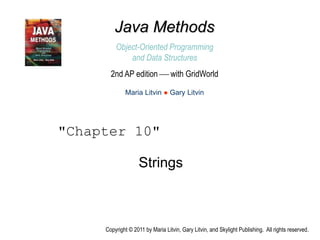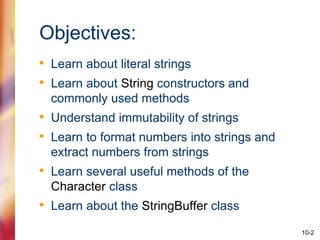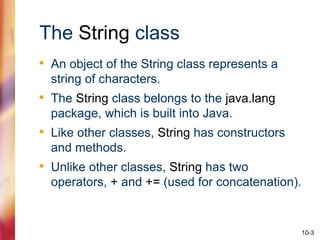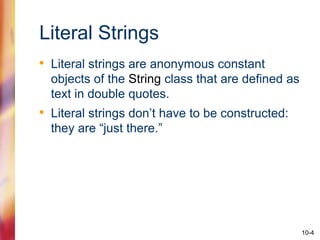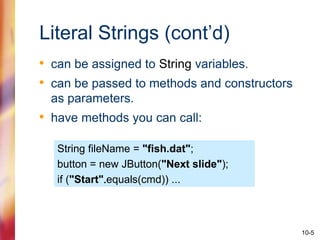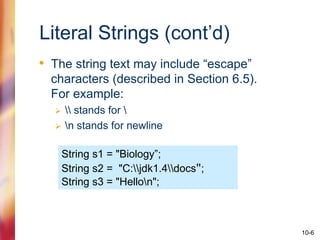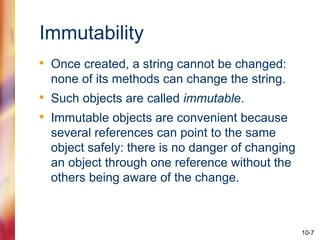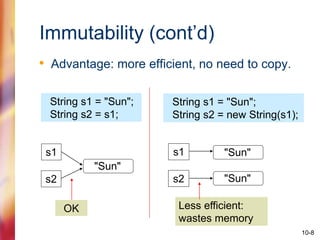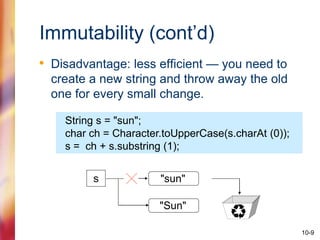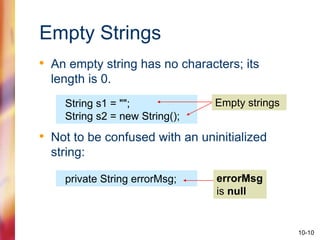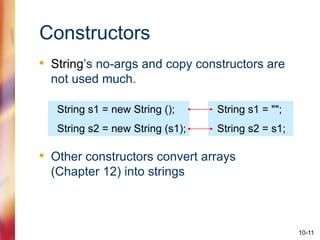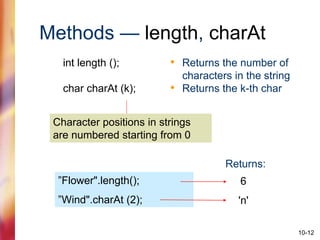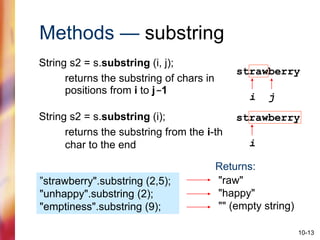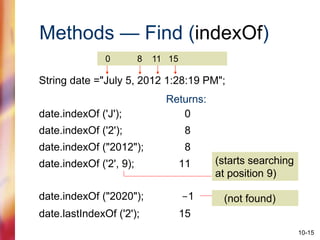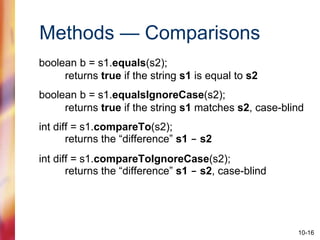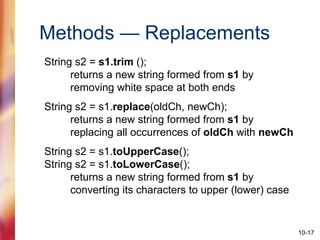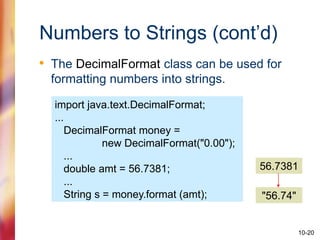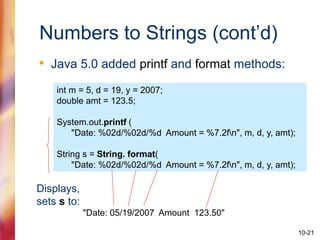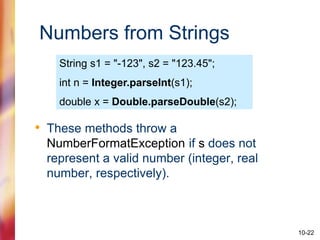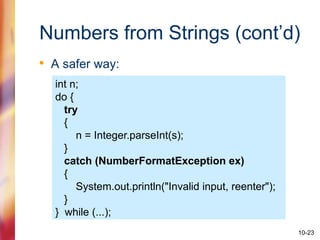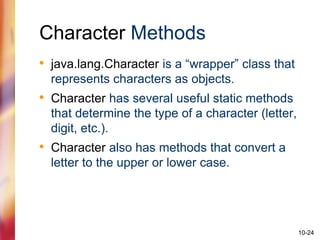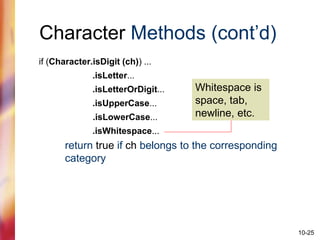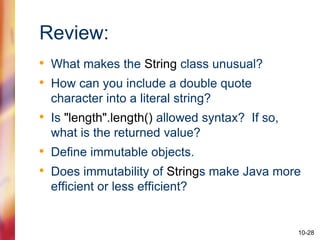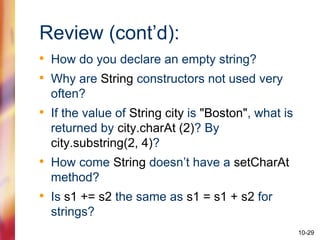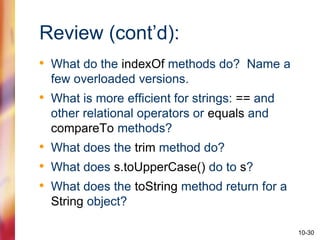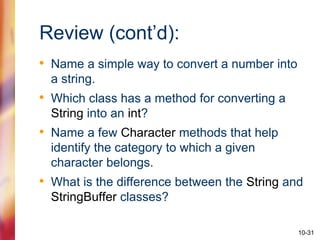String Method.pptx
- 1. Strings "Chapter 10" Copyright ÂĐ 2011 by Maria Litvin, Gary Litvin, and Skylight Publishing. All rights reserved. Java Methods Object-Oriented Programming and Data Structures Maria Litvin â Gary Litvin 2nd AP edition ïū with GridWorld
- 2. 10-2 Objectives: âĒ Learn about literal strings âĒ Learn about String constructors and commonly used methods âĒ Understand immutability of strings âĒ Learn to format numbers into strings and extract numbers from strings âĒ Learn several useful methods of the Character class âĒ Learn about the StringBuffer class
- 3. 10-3 The String class âĒ An object of the String class represents a string of characters. âĒ The String class belongs to the java.lang package, which is built into Java. âĒ Like other classes, String has constructors and methods. âĒ Unlike other classes, String has two operators, + and += (used for concatenation).
- 4. 10-4 Literal Strings âĒ Literal strings are anonymous constant objects of the String class that are defined as text in double quotes. âĒ Literal strings donât have to be constructed: they are âjust there.â
- 5. 10-5 Literal Strings (contâd) âĒ can be assigned to String variables. âĒ can be passed to methods and constructors as parameters. âĒ have methods you can call: String fileName = "fish.dat"; button = new JButton("Next slide"); if ("Start".equals(cmd)) ...
- 6. 10-6 Literal Strings (contâd) âĒ The string text may include âescapeâ characters (described in Section 6.5). For example: ï stands for ï n stands for newline String s1 = "Biologyâ; String s2 = "C:jdk1.4docs"; String s3 = "Hellon";
- 7. 10-7 Immutability âĒ Once created, a string cannot be changed: none of its methods can change the string. âĒ Such objects are called immutable. âĒ Immutable objects are convenient because several references can point to the same object safely: there is no danger of changing an object through one reference without the others being aware of the change.
- 8. 10-8 Immutability (contâd) âĒ Advantage: more efficient, no need to copy. String s1 = "Sun"; String s2 = s1; String s1 = "Sun"; String s2 = new String(s1); s1 s2 s1 s2 OK Less efficient: wastes memory "Sun" "Sun" "Sun"
- 9. 10-9 Immutability (contâd) âĒ Disadvantage: less efficient â you need to create a new string and throw away the old one for every small change. String s = "sun"; char ch = Character.toUpperCase(s.charAt (0)); s = ch + s.substring (1); s "sun" "Sun"
- 10. 10-10 Empty Strings âĒ An empty string has no characters; its length is 0. âĒ Not to be confused with an uninitialized string: String s1 = ""; String s2 = new String(); private String errorMsg; errorMsg is null Empty strings
- 11. 10-11 Constructors âĒ Stringâs no-args and copy constructors are not used much. âĒ Other constructors convert arrays (Chapter 12) into strings String s1 = new String (); String s2 = new String (s1); String s1 = ""; String s2 = s1;
- 12. 10-12 Methods â length, charAt int length (); char charAt (k); âĒ Returns the number of characters in the string âĒ Returns the k-th char 6 'n' âFlower".length(); âWind".charAt (2); Returns: Character positions in strings are numbered starting from 0
- 13. 10-13 Methods â substring String s2 = s.substring (i, j); returns the substring of chars in positions from i to j-1 String s2 = s.substring (i); returns the substring from the i-th char to the end "raw" "happy" "" (empty string) âstrawberry".substring (2,5); "unhappy".substring (2); "emptiness".substring (9); Returns: strawberry i j strawberry i
- 14. 10-14 Methods â Concatenation String result = s1 + s2; concatenates s1 and s2 String result = s1.concat (s2); the same as s1 + s2 result += s3; concatenates s3 to result result += num; converts num to String and concatenates it to result
- 15. 10-15 Methods â Find (indexOf) String date ="July 5, 2012 1:28:19 PM"; date.indexOf ('J'); 0 date.indexOf ('2'); 8 date.indexOf ("2012"); 8 date.indexOf ('2', 9); 11 date.indexOf ("2020"); -1 date.lastIndexOf ('2'); 15 Returns: (not found) (starts searching at position 9) 0 8 11 15
- 16. 10-16 Methods â Comparisons boolean b = s1.equals(s2); returns true if the string s1 is equal to s2 boolean b = s1.equalsIgnoreCase(s2); returns true if the string s1 matches s2, case-blind int diff = s1.compareTo(s2); returns the âdifferenceâ s1 - s2 int diff = s1.compareToIgnoreCase(s2); returns the âdifferenceâ s1 - s2, case-blind
- 17. 10-17 Methods â Replacements String s2 = s1.trim (); returns a new string formed from s1 by removing white space at both ends String s2 = s1.replace(oldCh, newCh); returns a new string formed from s1 by replacing all occurrences of oldCh with newCh String s2 = s1.toUpperCase(); String s2 = s1.toLowerCase(); returns a new string formed from s1 by converting its characters to upper (lower) case
- 18. 10-18 Replacements (contâd) âĒ Example: how to convert s1 to upper case âĒ A common bug: s1 = s1.toUpperCase(); s1.toUpperCase(); s1 remains unchanged
- 19. 10-19 Numbers to Strings âĒ Three ways to convert a number into a string: 1. String s = "" + n; 2. String s = Integer.toString (n); String s = Double.toString (x); 3. String s = String.valueOf (n); Integer and Double are âwrapperâ classes from java.lang that represent numbers as objects. They also provide useful static methods.
- 20. 10-20 Numbers to Strings (contâd) âĒ The DecimalFormat class can be used for formatting numbers into strings. import java.text.DecimalFormat; ... DecimalFormat money = new DecimalFormat("0.00"); ... double amt = 56.7381; ... String s = money.format (amt); 56.7381 "56.74"
- 21. 10-21 Numbers to Strings (contâd) âĒ Java 5.0 added printf and format methods: int m = 5, d = 19, y = 2007; double amt = 123.5; System.out.printf ( "Date: %02d/%02d/%d Amount = %7.2fn", m, d, y, amt); String s = String. format( "Date: %02d/%02d/%d Amount = %7.2fn", m, d, y, amt); Displays, sets s to: "Date: 05/19/2007 Amount 123.50"
- 22. 10-22 Numbers from Strings âĒ These methods throw a NumberFormatException if s does not represent a valid number (integer, real number, respectively). String s1 = "-123", s2 = "123.45"; int n = Integer.parseInt(s1); double x = Double.parseDouble(s2);
- 23. 10-23 Numbers from Strings (contâd) âĒ A safer way: int n; do { try { n = Integer.parseInt(s); } catch (NumberFormatException ex) { System.out.println("Invalid input, reenter"); } } while (...);
- 24. 10-24 Character Methods âĒ java.lang.Character is a âwrapperâ class that represents characters as objects. âĒ Character has several useful static methods that determine the type of a character (letter, digit, etc.). âĒ Character also has methods that convert a letter to the upper or lower case.
- 25. 10-25 Character Methods (contâd) if (Character.isDigit (ch)) ... .isLetter... .isLetterOrDigit... .isUpperCase... .isLowerCase... .isWhitespace... return true if ch belongs to the corresponding category Whitespace is space, tab, newline, etc.
- 26. 10-26 Character methods (contâd) char ch2 = Character.toUpperCase (ch1); .toLowerCase (ch1); if ch1 is a letter, returns its upper (lower) case; otherwise returns ch1 int d = Character.digit (ch, radix); returns the int value of the digit ch in the given int radix char ch = Character.forDigit (d, radix); returns a char that represents int d in a given int radix
- 27. 10-27 The StringBuffer Class âĒ Represents a string of characters as a mutable object âĒ Constructors: StringBuffer() // empty StringBuffer of the default capacity StringBuffer(n) // empty StringBuffer of a given capacity StringBuffer(str) // converts str into a StringBuffer âĒ Adds setCharAt, insert, append, and delete methods âĒ The toString method converts this StringBuffer into a String
- 28. 10-28 Review: âĒ What makes the String class unusual? âĒ How can you include a double quote character into a literal string? âĒ Is "length".length() allowed syntax? If so, what is the returned value? âĒ Define immutable objects. âĒ Does immutability of Strings make Java more efficient or less efficient?
- 29. 10-29 Review (contâd): âĒ How do you declare an empty string? âĒ Why are String constructors not used very often? âĒ If the value of String city is "Boston", what is returned by city.charAt (2)? By city.substring(2, 4)? âĒ How come String doesnât have a setCharAt method? âĒ Is s1 += s2 the same as s1 = s1 + s2 for strings?
- 30. 10-30 Review (contâd): âĒ What do the indexOf methods do? Name a few overloaded versions. âĒ What is more efficient for strings: == and other relational operators or equals and compareTo methods? âĒ What does the trim method do? âĒ What does s.toUpperCase() do to s? âĒ What does the toString method return for a String object?
- 31. 10-31 Review (contâd): âĒ Name a simple way to convert a number into a string. âĒ Which class has a method for converting a String into an int? âĒ Name a few Character methods that help identify the category to which a given character belongs. âĒ What is the difference between the String and StringBuffer classes?

